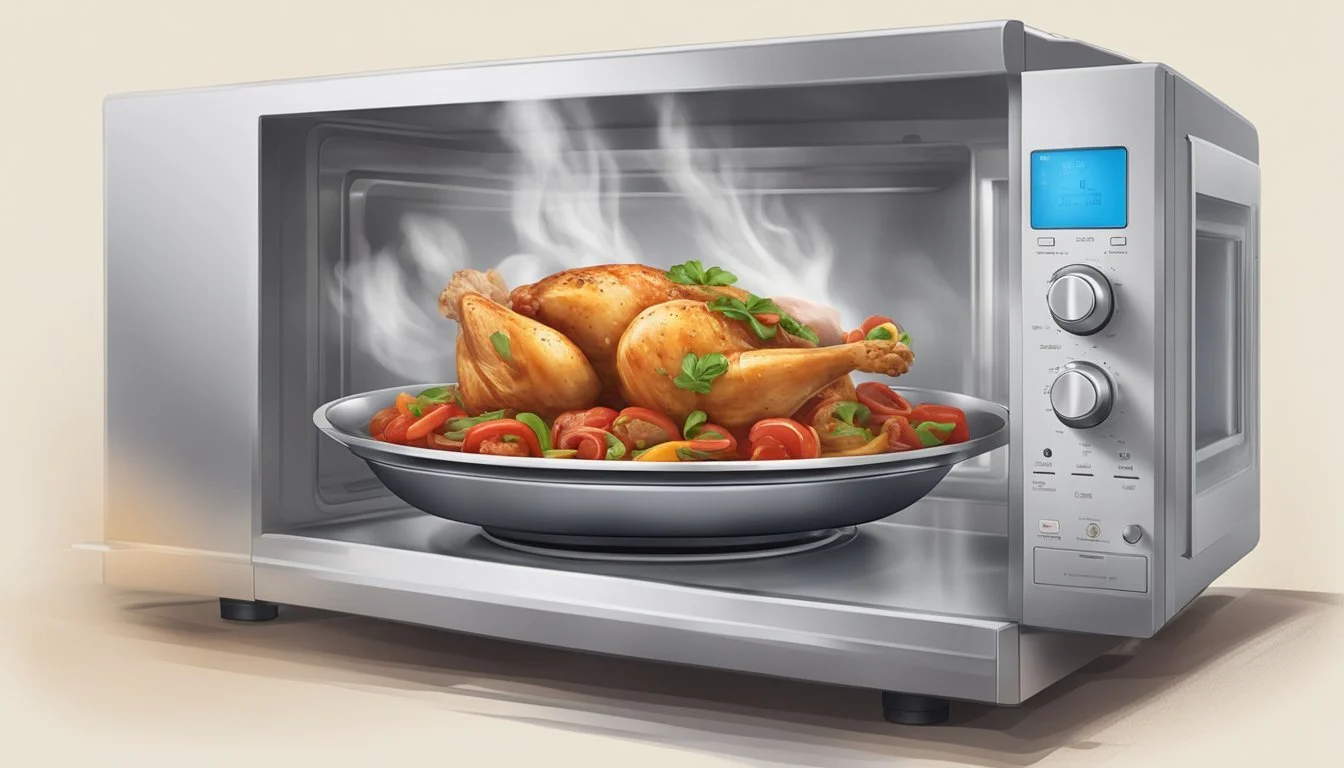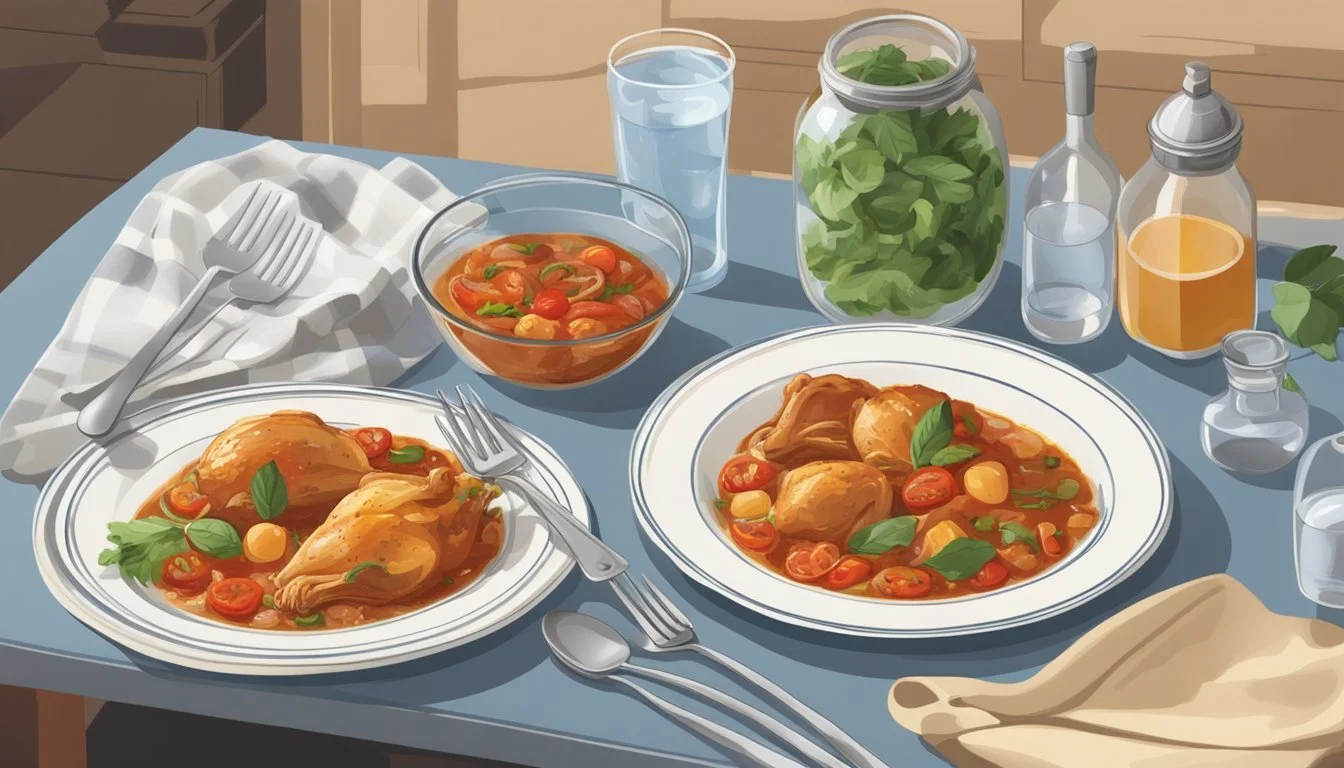How to Reheat Chicken Caccia
Simple Steps for Perfect Results
Reheating chicken cacciatore to perfection can be a simple task when done correctly. To preserve the savory flavors and tender texture, certain methods stand out for their effectiveness. Whether using a microwave for quick convenience or opting for an oven to maintain juiciness, selecting the right approach ensures a delicious meal.
Using a microwave, transfer the chicken cacciatore to a microwave-safe dish, cover it with a vented lid or plastic wrap, and heat gently to avoid drying out. For stovetop reheating, a skillet with a touch of oil brings back the dish’s richness, requiring occasional stirring for even warmth. Oven reheating, widely regarded for its ability to retain moisture, involves placing the chicken in a covered baking dish, prepped with a small amount of stock or water, and heating at 350°F until thoroughly warmed.
Reheating chicken cacciatore does not have to be a challenge. By following these straightforward techniques, anyone can enjoy their leftovers with minimal effort while maintaining the dish's delicious qualities.
Understanding Chicken Cacciatore
Chicken Cacciatore, an Italian classic, translates to “hunter-style chicken.” This traditional dish combines chicken with a rich and flavorful tomato sauce.
Key ingredients include onion, garlic, bell peppers, mushrooms, and olives. These vegetables contribute to the dish’s hearty texture and deep flavors.
Tomato sauce forms the base, simmering with the vegetables and ensuring the chicken stays tender and moist.
This dish is enjoyed as a comfort food in many Italian households, providing warmth and simple, yet satisfying, flavors. Each family might have their own variation, but the essence remains rooted in these fundamental elements.
Cooking methods may involve baking or simmering on the stove, infusing all ingredients with the aromas and richness of hunter-style cooking.
Storage Fundamentals
Proper storage of leftover chicken cacciatore is crucial to maintaining its flavor and ensuring food safety. This guide covers essential techniques for refrigerating and freezing chicken to keep it fresh.
Proper Storage Techniques
Refrigerate leftover chicken as soon as it cools to room temperature. Use an airtight container or wrap the chicken tightly in aluminum foil or plastic wrap. To prevent cross-contamination, store it on the top shelf away from raw meats. Label the container with the date to keep track of freshness.
Leftover chicken should be used within 3-4 days. If you have a large quantity, portion it into smaller containers; this makes reheating quicker and more convenient.
Freezing and Refrigerating Chicken
For longer storage, freeze leftover chicken. Place it in a freezer-safe bag or container, removing as much air as possible before sealing. Label it with the date, and use it within 2-3 months for optimal taste and quality.
When refrigerating, keep the temperature below 40°F (4°C). In the freezer, ensure the temperature is at 0°F (-18°C) or lower. Storing chicken at these temperatures reduces the risk of bacterial growth.
Thaw frozen chicken in the refrigerator, not at room temperature, to maintain food safety. This slow thawing method preserves texture and flavor. Use thawed chicken within 24 hours to ensure it remains fresh and safe to eat.
Preparing for Reheating
To ensure your chicken cacciatore retains its flavor and texture, it is vital to prepare it properly before reheating. Two critical steps are allowing the dish to reach room temperature and considering specific pre-reheating measures to preserve moisture and the integrity of the sauce.
Room Temperature Thawing
Allow the chicken cacciatore to reach room temperature before reheating. This step helps reheat the dish evenly, preventing cold spots.
Steps:
Remove the chicken cacciatore from the refrigerator.
Transfer to a container if it's not already in one.
Let it sit on the counter for 20-30 minutes. This gradual warming helps maintain the dish’s flavor and texture.
The sauce will also benefit, preventing separation and ensuring it heats through consistently. It's especially important if the dish contains bone-in chicken, which can take longer to warm.
Pre-Reheating Considerations
Before placing the chicken cacciatore in your chosen reheating device, evaluate the following:
Moisture: To prevent drying:
Add a small amount of liquid—like chicken broth or water—if the dish seems dry.
Stir the sauce to blend any separated oils and liquids.
Container Choice: Use a microwave-safe or oven-safe dish. Cover the dish with a lid or vented plastic wrap to trap steam. This will help keep the sauce and chicken moist.
Stirring/Mixing: For even reheating, make sure to stir or mix the dish if reheating on the stove or in the microwave. This ensures uniform temperature distribution without overcooking any part of the dish.
By taking these steps, the reheating process will be smoother, resulting in a delicious meal close to its original state.
Reheating Techniques
Reheating chicken cacciatore requires careful attention to preserve its flavors and textures. The following methods provide specific techniques to reheat the dish using different kitchen appliances for the best results.
Oven Reheating Method
To reheat chicken cacciatore in the oven, preheat the oven to 350°F (175°C). Place the chicken cacciatore in an oven-safe dish and cover it with aluminum foil to retain moisture.
Heat for about 20-25 minutes or until the internal temperature reaches 165°F (74°C). This method is excellent for evenly warming the dish without drying it out. Checking halfway through and stirring lightly can ensure even reheating.
Stovetop Reheating Method
For stovetop reheating, use a skillet on medium-low heat. Add the chicken cacciatore and cover the pan to retain moisture.
Heat for about 10-15 minutes, stirring occasionally to ensure even warmth. If the sauce appears too thick, add a splash of water or broth to maintain the desired consistency. This method is quick and particularly suited for those who want to keep the dish's rich flavors intact.
Microwave Reheating Method
Place the chicken cacciatore on a microwave-safe plate or dish. Cover it with a microwave-safe lid or a damp paper towel to prevent splattering and to retain moisture.
Reheat on medium power for 2-3 minutes, stirring halfway through. If needed, continue heating in 1-minute increments until the internal temperature reaches 165°F (74°C). Using medium power helps avoid overheating the dish, ensuring the chicken remains tender.
Air Fryer Reheating Method
An air fryer provides a unique way to reheat chicken cacciatore, keeping it crispy on the outside while moist on the inside. Preheat the air fryer to 350°F (175°C).
Place the chicken cacciatore in the air fryer basket, ensuring it is not overcrowded. Heat for 5-7 minutes, checking occasionally to avoid overcooking. This method adds a slight crispiness to the dish, enhancing its texture.
Ensuring Optimal Taste and Texture
When reheating chicken cacciatore, it's crucial to avoid common mistakes that can lead to a loss of texture and flavor. By paying attention to moisture levels and using the right techniques, you can enjoy a dish that's just as delicious as when it was freshly cooked.
Avoiding Common Reheating Mistakes
Common mistakes during reheating often involve overheating or improper techniques. Overheating can result in a loss of moisture, leading to dry and tough chicken.
Using too much heat can also cause the sauce to reduce too much, rendering it overly thick. To prevent this, reheating should be done at medium or low heat.
Another mistake is not adequately flipping or stirring the chicken. Uneven heating can cause some parts to become soggy while others remain cold.
Avoid using plastic wrap directly in the microwave. Instead, opt for a microwave-safe lid that allows steam to escape, ensuring even heating without splatters. Employing these methods will help maintain both texture and flavor consistency throughout the dish.
Enhancing Moisture and Flavor
To keep the chicken cacciatore moist and flavorful, adding a small amount of liquid can be beneficial. Pour a bit of chicken broth or water into the dish before reheating. This not only prevents dryness but also helps revive the aroma and taste of the sauce.
A light drizzle of olive oil can also enhance the flavors, adding a fresh and rich dimension to the reheated dish. Adding fresh herbs like basil or parsley near the end of reheating can elevate the aroma and taste, mimicking the freshness of a newly prepared meal.
Stove reheating can often yield better results than microwaving, as it allows for more control over the heat and prevents the dish from becoming soggy. Covering the skillet with a lid during heating can help retain moisture, while occasionally stirring or flipping the chicken ensures even heating.
Serving Reheated Chicken Cacciatore
After reheating your chicken cacciatore, it's essential to serve it in a way that complements the flavors and textures. Pairing it with the right accompaniments and adding the final touches can enhance the meal.
Accompaniments and Side Dishes
Chicken cacciatore pairs well with various side dishes. Pasta is a classic choice, with options like spaghetti, penne, or fettuccine working well to soak up the rich sauce. For a lighter option, brown rice or white rice provides a neutral base that complements the savory flavors of the dish.
Mashed potatoes offer a creamy texture that contrasts nicely with the tender chicken. Vegetables such as steamed broccoli, green beans, or roasted carrots add a nutritious and colorful side. A fresh salad with mixed greens, cherry tomatoes, and a light vinaigrette can provide a refreshing balance to the hearty cacciatore.
Final Touches and Presentation
When plating chicken cacciatore, sprinkle a generous amount of parmesan cheese on top for added flavor. Fresh parsley can be chopped and sprinkled over the dish to add a pop of color and freshness. Arrange the chicken pieces neatly on the plate, and pour some of the sauce over them for a more appealing look.
Serve the dish in a wide, shallow bowl to help contain the sauce and show off the ingredients. Adding a slice of crusty bread on the side can also be a delightful addition. This little detail can make the meal feel more complete and satisfying.
Safety and Best Practices
When reheating chicken cacciatore, food safety is paramount to ensure it is safe to eat.
Always reheat chicken to an internal temperature of 165°F (74°C). Use a food thermometer to check the temperature to avoid any guesswork.
Methods to Ensure Safety:
Microwave:
Transfer chicken cacciatore into a microwave-safe dish.
Cover with a microwave-safe lid or vented plastic wrap.
Heat in short intervals, stirring in between.
Oven:
Preheat to 350°F (175°C).
Place the chicken in an oven-safe dish and cover with foil.
Ensure the internal temperature reaches 165°F (74°C).
Stove:
Use a skillet with a small amount of water.
Heat over medium, stirring frequently.
Best Practices:
Avoid Cross-Contamination: Use clean utensils and dishes when handling reheated chicken.
Store Properly: Refrigerate leftovers within 2 hours of cooking.
Reheat Once Only: Repeated reheating can reduce quality and increase food safety risks.
Following these steps guarantees that the reheated chicken cacciatore is not only delicious but also safe to eat.






